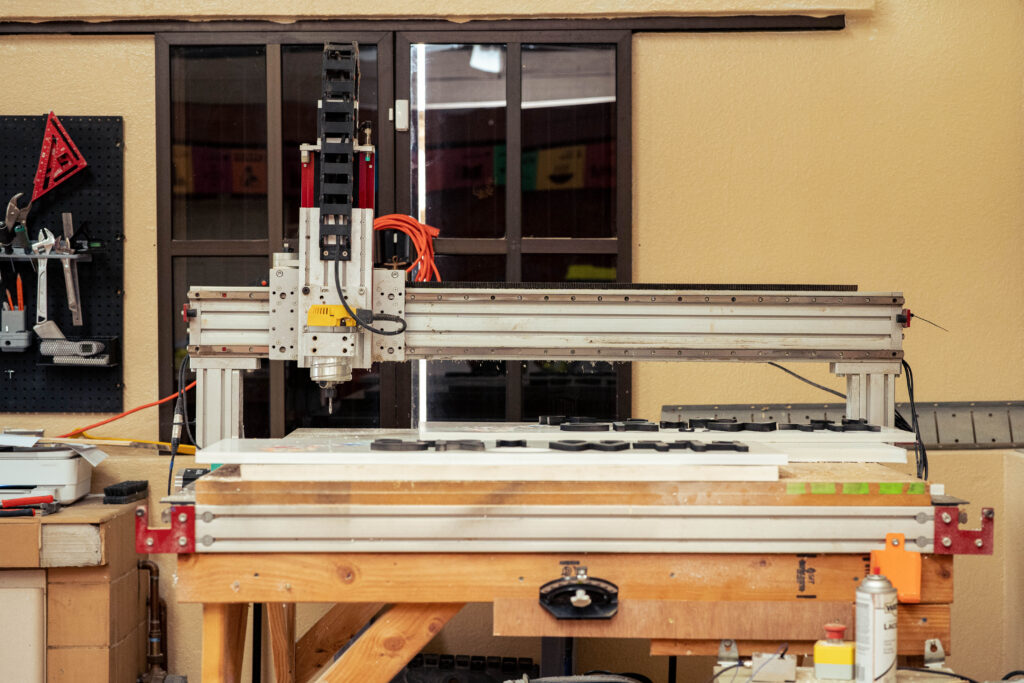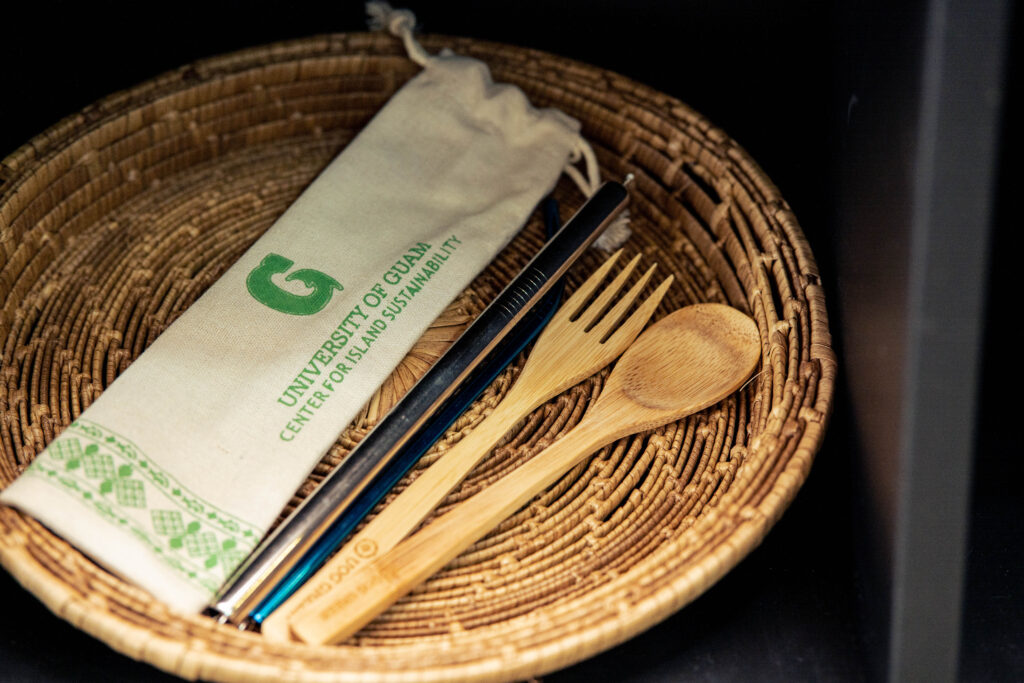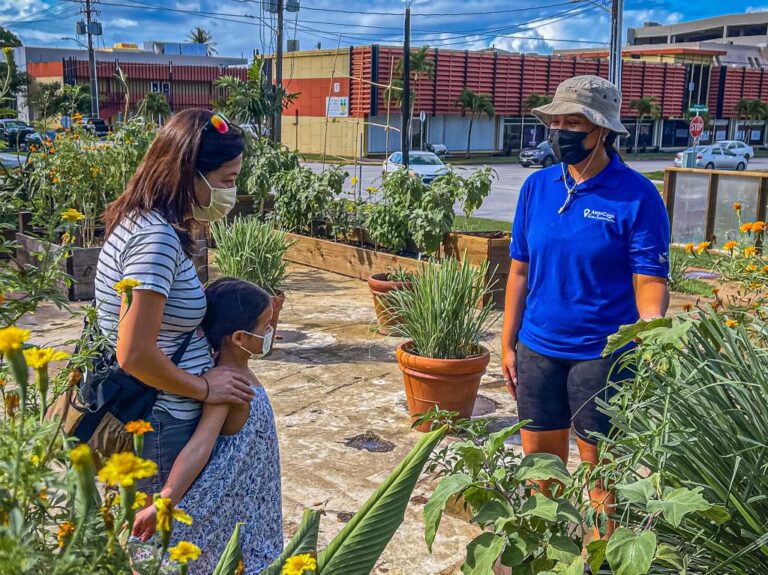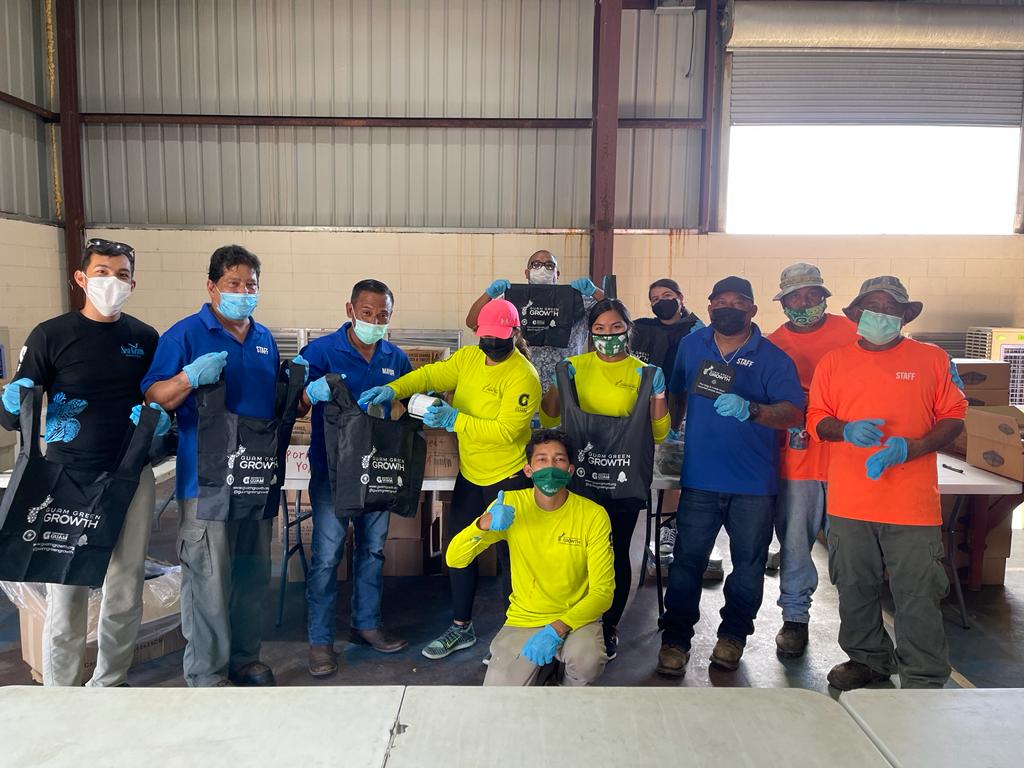#InTheNews – Our View: New Year is time for reflection
#InTheNews - Our View: New Year is time for reflection

Published in the Pacific Daily News
Photo by Rick Cruz
We enter 2022 as we entered 2021: under the shadow of a pandemic that continues to end lives and destroy livelihoods.
This is traditionally the time when we can reflect on what we, as a community, could have done better in 2021, and what we can do to make things better for everyone on the island in 2022.
One of the bright spots of the year was the work done by Guam Green Growth, which worked to keep the island clean and promote sustainability. The group distributed reusable shopping bags, started a community garden in Hagåtña, graduated its first conservation corps and is getting ready to open a maker space in CHamoru Village…
#INTHENEWS: Guam Green Growth Makerspace and Innovation Hub to open at CHamoru Village
#INTHENEWS: Guam Green Growth Makerspace and Innovation Hub to open at CHamoru Village

By Madison Scott
Pacific Daily News
Creators and innovators of Guam, get ready for a new playground! The Guam Green Growth Circular Economy Makerspace and Innovation Hub is opening in a few short weeks in CHamoru Village in Hagåtña, and G3 circular economy coordinator Myracle Mugol is eager to get folks through their doors.
“We need a community, we need the collaborations. We already have the physical aspects of the machines and equipment to do the process. Now, we need to be able to have the thought leaders and the subject matter experts — and bring it to the community who want to learn, who wants to expand. And that’s going to happen through our hub. We’re going to be the one stop shop for all things circular economy,” Mugol said.
UOG Center for Island Sustainability and Sea Grant assist with aquaculture feasibility study with big implications for Guam’s future
UOG Center for Island Sustainability and Sea Grant assist with aquaculture feasibility study with big implications for Guam’s future

The University of Guam Center for Island Sustainability and Sea Grant have been tapped to assist in a feasibility study that explores the potential of aquaculture as a viable industry on the island.
Hawai’i-based aquaculture expert Jim Wyban spoke about the study at the monthly aquaculture stakeholders meeting on Thursday, Dec 9, at the UOG College of Natural and Applied Sciences.
The Guam Economic Development Authority commissioned Wyban to develop the study with funding support from the FY 2019 EDA Disaster Supplemental grant.
The “Guam Aquaculture Industry Feasibility Study” components include site analysis and a conceptual design for an aquaculture center, which would be the first of its kind on Guam.
While on Guam, Wyban worked with UOG Sea Grant aquaculture extension specialist David Crisostomo. They visited several potential sites for the center and conducted meetings with stakeholders.

“I am trying to learn as much as I can about aquaculture on Guam — what happened in the past and what’s possible for the future. In addition, we are looking at sites that are possibilities for this concept, which will be a Guam Aquaculture Innovation Center,” Wyban said.
He added that the facility would be like the Fadian hatchery but on a larger scale. “It is focused on innovation in aquaculture, using and demonstrating, adapting to and developing the newest technologies.”
Wyban said he is modeling the proposed facility to the Hawai’i Ocean Science and Technology Park. “Basically, it is a state-owned facility that subleases sites within the facility to commercial companies. There are like 35 aquaculture companies down there,” he said.
The park is administered by the Natural Energy Laboratory of Hawai’i Authority, whose mission is to develop and diversify the Hawai’i economy by providing resources and facilities for energy and ocean-related research, education, and commercial activities in an environmentally sound and culturally sensitive manner.
At the meeting, several speakers also touched on the local and federal permitting requirements for an aquaculture business or facility on Guam. Wyban said that having a streamlined permitting process is crucial to attracting potential investors to the local aquaculture industry.
According to Wyban, the feasibility study will be completed by March 2022.
The UOG Center for Island Sustainability and Sea Grant have been working to develop aquaculture opportunities on Guam, recently completing setup and fish introduction at the first community aquaculture system at Island Girl Power in Dededo.
The group has held training sessions with stakeholders and partners and plans to set up aquaculture systems at various community centers and non-profit organizations as a continuation of the program in the coming year.
Come spark new industries in new Guam Green Growth Makerspace
Come spark new industries in new Guam Green Growth Makerspace







Entrepreneurs and creators throughout the island can put their innovative abilities to work and transform waste into marketable products at one convenient location in the coming weeks.
The Guam Green Growth (G3) Circular Economy Makerspace and Innovation Hub will celebrate its grand opening to the public at 3:30 p.m. January 13, 2022, out of three houses at the CHamoru Village in Hagåtña.
The spaces will provide creators resources to upcycle items and materials in contribution to Guam’s emerging green economy. Moreover, the effort will help address the overreliance on imported products and increased amount of waste generated locally.
Alongside a green store and innovation hub offering local merchandise for the environmentally conscious and guidance for those seeking business advisement, the maker space house features an abundance of tools capable of processing wood, metal, various other materials, and plastic in a third house devoted to world-renowned Precious Plastic machines.
For a fee, creators can access a laser cutter, computer numerical control router, 3D printer, vinyl cutter, and apparatuses to shred, extrude, inject, press, and melt plastic, among other convenient equipment. Patrons can avail of the services for $50 per month or $500 per year with a 20% discount applicable to yearly memberships.
The G3 Circular Economy Makerspace and Innovation Hub also supports G3’s mission toward establishing sustainable and profitable cottage industries, improving the performance of enterprise facilitation and development programs, and supporting regional economic development.
The center’s managing and support staff are seasoned in business and product development and are willing to share their skills and knowledge with those utilizing the spaces. Those eager to learn can attend creative workshops and hear from members of the University of Guam (UOG) School of Business and Public Administration, Guam Unique Merchandise and Arts, the Small Business Development Center, and the Guam Economic Development Authority. Additionally, products created can be sold in the green store on consignment.
Myracle Mugol, G3 circular economy coordinator, sees the operation as a place to grow with like-minded people and convenient resources, what she says can be missing factors for ideas to come to fruition.
“When people ask me about the space and all the things that come with it, I tell them it’s my three Cs of G3: curation of equipment, tools, and workshops to make our ideas happen; collaboration with development and resource partners, who assist with the innovation and expansion into business and cooperatives; and community – the people surrounding these spaces, who allow for ideas to grow, develop, and move,” said Mugol.
“The community is the support and backbone for sustainability; the very change-makers who push the culture needed for the initiatives to move forward,” she continued.
“Our team looks forward to the opening of the G3 Circular Economy Makerspace and Innovation Hub and all the creative products that will be developed by our talented community,” stated Dr. Austin Shelton, director of the UOG Center for Island Sustainability and Sea Grant. “The hub will reduce our island’s waste and diversify our economy through the stimulation of new green industries.”
The G3 Circular Economy Makerspace and Innovation Hub is funded by the National Science Foundation’s Established Program to Stimulate Competitive Research Guam Ecosystems Collaboratorium for Corals and Oceans, better known as EPSCoR GECCO, GEDA, and the Office of the Governor.
Ahead of the January 13 grand opening, the Guam Green Growth Circular Economy Makerspace and Innovation Hub is currently open for small tours which can be arranged via email to mugolm@triton.uog.edu.
About G3
Aligned with the 17 U.N. Sustainable Development Goals, the Guam Green Growth Initiative, or G3, cultivates an ecosystem for transformative action to achieve a sustainable, prosperous, and equitable future for Guam. The University of Guam facilitates the island-wide initiative in cooperation with the Office of the Governor of Guam and the 99 members of the G3 Working Groups, representing all sectors of society.
#INTHENEWS: Shelton: strategic alliances key to ensuring Guam’s sustainable future
Shelton: strategic alliances key to ensuring Guam's sustainable future

From KUAM.COM
By: Isaiah Aguon
On Wednesday’s G3 Steering Committee meeting, director for the University of Guam’s Center for Island Sustainability Dr. Austin Shelton, shared updates on the Guam Green Growth’s projects to make the island more sustainable.
Guam Green Growth Community Garden hosts Guåhan Sustainable Culture kids’ workshops
Guam Green Growth Community Garden hosts Guåhan Sustainable Culture weekly workshops

Guåhan Sustainable Culture (GSC) and AmeriCorps GSC are bringing weekly educational outreach to the Guam Green Growth Community Garden with the launch of weekly community workshops.
The activities are free to the public and aim to encourage participation and sustainable development amongst families on Guam.
The weekly schedule includes Monday’s HomeGrown Giving and Seeds Giveaways, Garden Tour Day every Tuesday, Container Gardening Workshops on Thursdays, Seedling giveaways every Friday and special Neni Activities on certain Saturdays.
According to Guåhan Sustainable Culture president Michelle Crisostomo, teaching the younger members of the community about food security and farming can help prepare them for a healthier lifestyle.
“One of our goals is to help teach people about healthier lifestyles and that is important at an early age,” said Crisostomo. “People have a lot of health issues including high blood pressure and diabetes on Guam and we want to teach people to eat healthier and eat local. We want to teach it to them at an early age and make it fun and enjoyable.”
Crisostomo says the lessons learned in the garden go further than just the time of the visit.
“The garden itself serves as a demonstration garden for people who want to grow their own food at home,” explained Crisostomo. “The garden gives people inspiration for projects they want to start at home so they can incorporate what they learn, take it back and teach people in their families how to do it. It helps in the big picture of food sustainability.”
No stranger to using her hands in the dirt, mother of seven, Eunice Aflague, brought her two sons to the Neni Garden Activities held on December 11 at the G3 Community Garden for some exposure to farming.

“I brought my younger kids because my older kids were never exposed to programs like this and I grew up planting and farming and I wanted them to get exposed to that too,” said Aflague. “This (community garden) is very beneficial and I wish there were more of them, because in the future, a lot of this generation will not know what planting is, not like we did.”
Aflague says she hopes that the lessons her children learn at the G3 Community Garden will be applied at home.
“I started a little garden, and I want my kids to be more enthusiastic so that on the Homefront, they will come out and help me expand our home garden,” said Aflague.
The activities are facilitated by the Guahan Sustainable Culture Americorps members and include gardening, recycling, and sustainability lessons for children of all ages.
Members of the community are welcome to visit the garden in Hagatña, across the street from the Post Office and Skinner Plaza at any time during the week.
Registration and the full schedule of events can be found online at https://www.gusustainable.org/americorps as well as on the group’s social media pages.
The G3 Community Garden is a project of the island-wide Guam Green Growth (G3) initiative, a public-private partnership facilitated by the Center for Island Sustainability at the University of Guam and supported by the Office of the Governor that creates solutions to sustainability challenges and fosters the island’s alignment with the United Nations’ 17 Sustainability Development Goals (SDGs). The community garden addresses SDG #2: Zero Hunger, SDG #3: Good Health and Wellbeing, and SDG #11: Sustainable Cities and Communities and is maintained by Guåhan Sustainable Culture.
#INTHENEWS: Recycling bins will be distributed to all villages
Recycling bins will be distributed to all villages

FROM: PNCGUAM.COM
By: Gerry Partido
Recycling bins are set to be distributed to all villages on island by Guam Green Growth (G3) with the assistance of the Department of Public Works.
Guam Green Growth is a public-private partnership that develops tangible solutions to sustainability challenges and contributes to a green economy for the island region.
Dr. Austin Shelton, who heads the Center for Island Sustainability which oversees G3, said the recycling bins are now on island and they are just putting on the decals.
“We hope to install these recycling bins at a site of your choice in your villages in 2022, maybe we’ll even be able to get a few of them done before the end of the year,” Austin said during the last Mayors Council meeting.
Guam Green Growth recognizes first cohort of Conservation Corps graduates
Guam Green Growth recognizes first cohort of Conservation Corps graduates

An innovative program designed to establish the foundation for workforce development in an emerging green economy achieved a milestone this month by holding its first graduation.
The University of Guam’s Guam Green Growth Initiative recognized its first batch of conservation corps graduates on Friday, Nov. 19, at the Ricardo J. Bordallo Governor’s Complex (Adelup) in Hagåtña.

The following Conservation Corps members graduated from the program: Nikomang Bradley, Joseph Certeza, Alana Chargualaf, Abby Crain, EnyDennis Dali, Claudia Rosalia Guerrero, Jacqueline Jones, Drake Kemp, Lusech Ngirakesau, Daniel Stone, Kaya Taitano, and Kevin Wong.
G3 launched the conservation corps program in partnership with UOG Center for Island Sustainability and UOG Global Learning and Engagement in June. For the past five months, the 12 members trained full time on various sustainability topics, such as agriculture and aquaculture, island beautification, invasive species removal, reforestation, circular economy and recycling, to renewable energy.
“Through the G3 Conservation Corps program, the 12 corps member are now trained in these focus areas, and these can be applied in agencies, organizations, and businesses to help transition our island into a green economy,” UOG President Thomas Krise said on the conservation corps’ contribution to G3’s overarching goal.
Krise said the members will receive continuing education units for completing the workforce development program. “This is supported by our partnership with the Global Learning Education and the Center for Island Sustainability. This is such a great way to combine education with all your other successes,” Krise said, addressing the members of the conservation corps.

At the graduation, Austin Shelton, UOG Center for Island Sustainability and Sea Grant director, highlighted the contributions of the first batch of Conservation Corps members. “When Guam Green Growth started, I shared that sustainability is about human society, the natural environment, and the economy. And you [graduates] have been an important part of getting ready to prepare our community and our workforce for the emerging green economy.”
From Jun. 23 to Nov. 9, 2021, the conservation corps accomplished the following:
- Engaged community participants and leveraged 4,149 volunteer hours
- Picked up 578 extra-large bags of trash, removed 211 white goods and bulky waste;
- Collected and recycled 70,516 aluminum cans;
- Installed 641solar panels and changed 693 fluorescent bulbs to LED;
- Prepped 10 acres of land for reforestation projects;
- Planted 2,890 trees and 2,024 food crops;
- Built 690 ft. of erosion control devices;
- Completed 9 painting projects (murals, bus stops, safety barricades, etc.);
- Conducted 6 beach and 19 roadside cleanups, and;
- Removed 400 feet of chain of love and 212 invasive bamboo stalks.
At the ceremony, Lt. Governor Joshua Tenorio commended the conservation corps graduates, “I am really happy and grateful for this great partnership with the University of Guam Center for Island Sustainability and really how all of you are pioneers in this movement to transform the island. In many ways and across many disciplines, the public sector, private sector and civil society.”
WHAT IS G3?
Guam Green Growth or G3 is the island’s most comprehensive public-private partnership created to achieve a sustainable future. Aligned with the 17 UN Sustainable Development Goals, G3 cultivates an ecosystem for transformative action to achieve our island’s sustainable, prosperous, and equitable future. UOG facilitates the island-wide initiative in cooperation with the Office of the Governor of Guam and the 99 members of the G3 Working Group representing all sectors of our society.
G3CC prepares commodities for community distribution in Yoña
G3CC prepares commodities for community distribution in Yoña

As the Guam Green Growth Conservation Corps program winds down, the group kicked it into high gear as they stepped in to assist the Yoña Mayor’s Office prepare over 340 commodity bags for distribution to the community this week.
Corps members packed various food items into bags that will be distributed to villagers by the Mayor and his team in line with Covid-19 support programs.
According to Quenga, over 500 people are assisted with every commodity distribution event in Yoña. He says that in the past, the prepping of bags took his staff away from other pressing village needs.
“I am so grateful for the help. Now that Guam Green Growth is here, our guys can go take care of the village,” said Quenga.

Conservation Corps members formed an assembly line to prepare the bags and ensure efficiency.
“When you saw at the end of the process, and see how much of it would have been plastic it’s great to see the Reusable bags,” said G3CC Member Abby Crain. “Contributing community support and knowing it’s going to help sustain someone during these tough times is an awesome feeling.”
The Corps has volunteered in every village on Guam throughout the duration of the five-month program coordinating beautification cleanups, paintings and more.
“Guam Green Growth is an awesome program. They reach out to all the villages and help all the villages,” said Quenga. “They have so many ideas to put into play and they are here today proving that they are here to help every village.”
Guam Green Growth also provided reusable tote bags for the commodities to be packed in, curbing the use of single-use plastic bags that are set to be illegal on January 1, 2022.
Guam Green Growth prepares the community for the emerging green economy. The program aligns with the current island wide efforts to achieve sustainability and other U.N. Sustainable Development Goals. Meanwhile, implementing a circular economy on the island contributes to achieving multiple U.N. SDGs, including SDG 12 (sustainable consumption and production), SDG 13 (climate change), and others.








